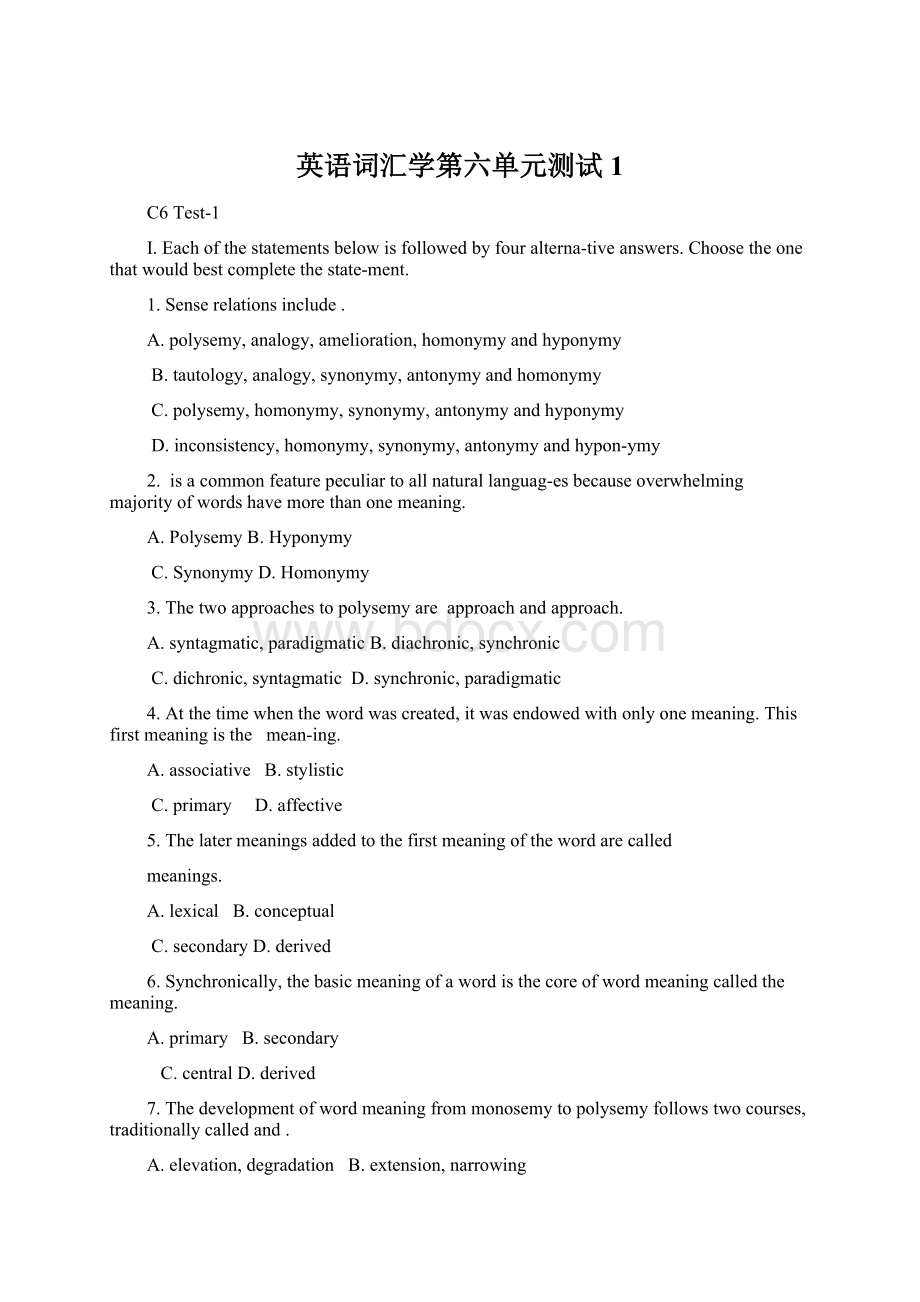英语词汇学第六单元测试1Word文档格式.docx
《英语词汇学第六单元测试1Word文档格式.docx》由会员分享,可在线阅读,更多相关《英语词汇学第六单元测试1Word文档格式.docx(21页珍藏版)》请在冰豆网上搜索。

A.lexicalB.conceptual
C.secondaryD.derived
6.Synchronically,thebasicmeaningofawordisthecoreofwordmeaningcalledthemeaning.
A.primaryB.secondary
C.centralD.derived
7.Thedevelopmentofwordmeaningfrommonosemytopolysemyfollowstwocourses,traditionallycalledand.
A.elevation,degradationB.extension,narrowing
C.radiation,concatenationD.radiation,extension
8.Radiationisasemanticprocessinwhichthemean-ingstandsatthecenterandthemeaningsproceedoutofitineverydirectionlikerays.
A.secondary,primaryB.primary,secondary
C.conceptual,associativeD.lexical,grammatical
9.Inthederivedmeaningsaredirectlyconnectedtothemeaning.
A.concatenation,centralB.radiation,primary
C.radiation,secondaryD.concatenation,associative
10.Generally,precedes.
A.concatenation,radiationB.widening,concatenation
C.narrowing,wideningD.radiation,concatenation
11.arewordsdifferentinmeaningbuteitheridenticalbothinsoundandspellingoridenticalonlyinsoundorspelling.
A.HomographsB.Homonyms
C.PerfecthomonymsD.Homophones
12.Perfecthomonymsare.
A.homographsB.bothhomophonesandhomographs
C.homophonesD.identicalbothinsoundandspelling,butdifferentinmeaning
13.Allofthefollowingarethesourcesofhomonymsexcept.
A.changeinsoundandspellingB.shortening
C.borrowingD.extension
14.ThesourcesofEnglishsynonymsexclude.
A.dialectsandregionalEnglish
B.figurativeandeuphemisticuseofwords
C.extension,narrowing,elevationanddegradationofwords
D.coincidencewithidiomaticexpressions
15.Thedifferencesbetweensynonymsboildowntothreeareas:
.
A.elevation,connotation,application
B.connotation,elevation,degradation
C.connotation,denotation,application
D.amelioration,deterioration,denotation
16.Byconnotationwemeantheandco-louringofwords.
A.derogatory,commendatory
B.stylistic,emotive
C.rhetoric,semantic
D.emotive,collocative
17.“lump”,“slice”,“chunk”,“sheet”and“cake”havethesamemeaning,“piece”,buttheyaredifferentin.
A.conceptual,connotationB.lexical,denotation
C.conceptual,applicationD.associative,collocation
18.Thetwofeaturesofcontradictorytermsareand.
A.mutuallyexclusive,non-gradableB.inclusive,exchangeable
C.relative,interdependentD.relational,interdependent
19.“east/west”are.
A.contrarytermsB.contradictoryterms
C.relativetermsD.co-hyponyms
20.Peopleuseantonymsinidiomsto.
A.expressideaseconomicallyforthesakeofcontrast
B.formantithesistoachieveemphasis
C.bothAandB
D.reachclimax
21.Contrarytermsaregradableantonyms,differingindegreeof.
A.formalityB.rhetoriccolouring
C.assimilationD.intensity
22.“hate/love”are.
A.contrarytermsB.contradictoryterms
C.relativetermsD.complementaryantonyms
23.Leastantonymsarefoundamongnounswhicharenamesof.
A.objectsB.ideas
C.domainsD.alltheabove
24.“compounding”and“composition”are.
A.absolutesynonymsB.relativesynonyms
C.stylisticsynonymsD.emotivesynonyms
25.Homonyms,particularly,areoftenemployedtocreatefordesiredeffectof,say,humour,sarcasmorridicule.
A.homographs,puns
B.homophones,antithesis
C.homophones,puns
D.homographs,antithesis
26.Whenawordisfirstcoined,itisalways.
A.monosemicB.polysemic
C.neutralD.informal
27.A/anhasmoresemantic:
componentsthana/an.
A.superordinateterm,subordinateterm
B.subordinateterm,superordinateterm
C.grammaticalwont,lexicalword
D.nativewonl,loanword
28.“teacher”anti“student”are.
A.relativetermsB.contraryterms
C.contradictoryD.superordinates
29.“piglet”,“chicken”,“child”and“duckling”sharethesamesemanticcomponent
A.animalB.adult
C.maleD.young
30.A/anisgeneralanda/anisspecific.
A.hyponym,subordinateterm
B.superordinate,subordinateterm
C.polysemant,monosemant
D.lowerterm,upperterm
31.Thedifferencesbetweensynonymslieinthreeaspectsexcept.
A.grammaticalmeaningB.application
C.connotationD.denotation
32.“widow/widower”are.
A.eontradictoryantonymsB.relativeantonyms
C.contraryantonymsD.notantonyms
33.Absolutesynonymsare.
A.numerousB.rare
C.popularD.common
34.Associativemeaningcomprisesseveraltypesexcept.
A.connotativemeaningB.stylisticmeaning
C.affectivemeaningD.lexiealmeaning
35.Homonymsaregenerallywordsdifferentinbutei-theridenticalbothinoridenticalonlyin.
A.sound;
meaningandspelling;
meaningorspelling
B.meaning;
soundandspelling;
soundorspelling
C.spelling;
meaningandsound;
D.meaning;
sound
36.Relativesynonymsalsocallednear-synonymsaresimilarornearlythesamein
A.affectivemeaningB.conceptualmeaning
C.eollocativemeaningD.stylisticmeaning
37.Theoriginsofhomonymsare.
A.changeinsoundB.shortening
C.borrowingD.alltheabove
38.Inconcatenation,betweenthelatestsenseandtheoriginalsense,thereisinmanycases.
A.asignofconnectionbetweenthem
B.somesignsofconnectionbetweenthem
C.notasignofconnectionbetweenthem
D.manysignsofconnectionbetweenthem
39.Indiachronicapproach,othermeaningsapartfromthepri-marymeaningofawordwereacquiredby.
A.extensionandtransferB.narrowing
C.analogyD.alltheabove
40.Themostimportantsourcesofsynonymsisperhaps.
A.dialectsandregionalEnglish
B.borrowing
C.figurativeandeuphemisticuseofwords
D.eoincidencewithidiomaticexpressions
II.Completethefollowingstatementswithproperwordsorexpressionsaccordingtothecoursebook.
1.“some”and“sum”are.
2.“date”and“date”areidenticalbothinsoundandspelling,butdifferinmeaning.Theyare.
3.Fromthepointofview,polysemyisassumedtobetheresultofgrowthanddevelopmentofthesemanticstructureoftheoneandsameword.
4.Synonymssharealikenessinaswellasinpartofspeech.
5.Thedevelopmentofwordmeaningfrommonosemytopolysemyfollowstwocourses,traditionallyknownasradiationand.
6.Perfecthomonymsandpolysemantsarefullyidenticalwithre-gardtospellingand.
7.Synchronically,polyscmyisviewedastheofvariousmeaningsofthesamewordinacertainhistoricalperiodoftime.
8.Synonymscanbeclassifiedintotwomajortypes:
absolutesyn-onymsand
synonyms.
9.Theoriginalmeaningof“pain”was“”.
10.Whenawordisfirstcoined,itisalways.
11.Wordsarearbitrarysymbolsandareindependententitiessofarastheirouterfacet——spellingand,isconcerned.
12.Diachronically,themeaningsofapolysemantincludeapti-marymeaningand
meanings.
13.Synchronically,themeaningsofapolysemantincludeacen-tralmeaningand
meanings.
14.Concatenationdescribesaprocesswhereeachofthelatermeaningsisrelatedonlytotheprecedingonelike.
15.Homophonesandhomographsarehomonyms.
16.Ofperfecthomonyms,homographsandhomophones,constitutethelargestnumberandaremostcommon.
17.Synonymsarethewordswhichhavethesameorverynearlythesame
meaning.
18.Relativesynonymsaredifferentindenotation,andapplication.
19.Synonymscanbedefinedaswordsdifferentinsoundandbutmostnearlyalikeorexactlythesameinmeaning.
20.Differenceinconnotationbetweensynonymsreferstothedif-ferencein
andemotivecolouringofwords.
21.“policeman”and“constable”arestylistically,yettheformerisusedbothinBritishEnglishandAmeri-canEnglishwhilethelatterisonlyinBritishEnglish.
22.“big”isgenerallyusedtoshowthebignessofsize,volume,extent,weight,number,andsoon,anyemotivecolouring.
23.Contrarytermsareantonyms,differingindegreeofintensity,soeachhasitsowncorrespondingopposite.
24.Ineachpairofcontradictoryterms,theofoneisthedenialoftheother.
25.Contrarytermsarebestviewedintermsofascalerunningbe-tweentwopolesor.
26.Withregardtocontraryterms,thetwooppositesaregradableandoneexists
theother.
27.Thereisa/anoppositionbetweencontradictoryterms.
28.Inthecaseofrelativeterms,theoppositionisonly.
29.Semanticisonecharacteristicofcontraryterms.
30.Wordsdenotingnature,qualityorstateofthingshavemanyantonyms.Thisaccountsforthelargenumberofantonymsamong.
31.Thehyponymsunderthesamesuperordinateare.
32.Onthebasisofopposition,antonymsareclassifiedintocontradictoryterms,contrarytermsandrelativeterms.
33.“do